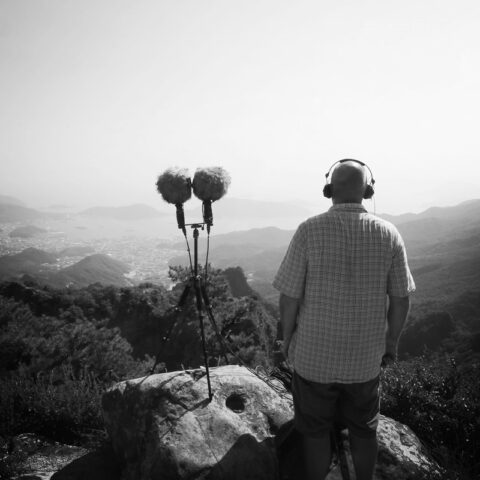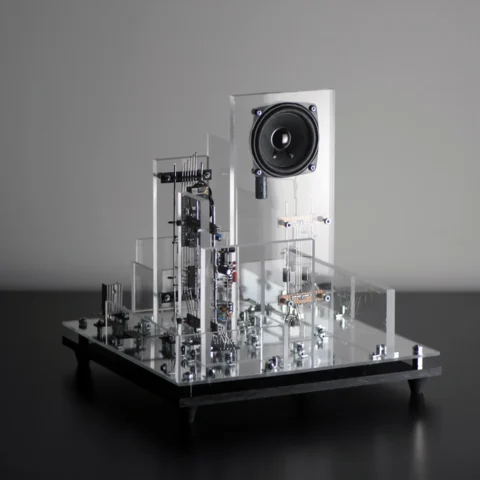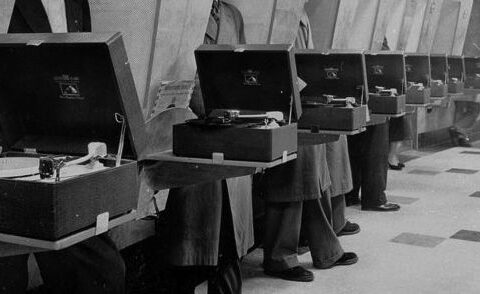[Article about the recording and editing process of Guns SFX Library released at BOOM. The article was written by Axel Rohrbach exclusively for Sonic Terrain.]
This is the “post mortem” article for Boom Library’s third collection:”Guns”. Since I had some major issues during the planning already, I will describe that process as well and hopefully that will help some of you guys with your future sessions. In some parts this was the most terrible recording session in my whole life, especially before the recording itself happened. On the other hand it was the most inspiring one, lots of fun with loaded guns..
The planning
The planning period started about 4 month before the actual recording session happened.BOOM Library HQ is based in Germany and recording guns here is not easy at all.It is tough to find dry, empty vast spaces and – the most intriguing thing – most of the European people do NOT own any guns (figure that!). That is why I decided to ask Jeff Ball, a friend and composer, living near TriCities in Washington, if he could help me out. He got me in contact with two guys who are private weapon collectors – a species that is rather hard to find in Europe. . We made up a list of weapons we can record and I started making Excel sheets defining “must haves” and “nice to haves”, runtimes, schedules and so on.
In the meantime I started collecting equipment. I personally do have a bunch of mics here, but the only useful recorder I have for such recordings is the Sound Devices 744T with two attached mic preamps, Sound Devices’ MP-1. Also, I did not want to carry too much gear with me because of the high security aspects flying overseas. I was afraid the equipment might be confiscated at an airport because someone thought this was a bomb or something. Including batteries, lots of cables, electronic devices and so on, I can imagine how dangerous the bag looked like through an X-ray. I started contacting different audio rental services. I wasn’t able to find any in Seattle where I would have been able to pick the equipment up myself, so I rented the stuff in Los Angeles and had it shipped to Jeff’s house.
I will not name the company here, because not everything went flawless. Anyway: asking for specific equipment four month before I wanted to rent them should be enough time – at least that was what I thought. Giving the fact, that the rental service knew that the recording was still some time ahead, they kind of made it like priority C. About three weeks before the recording session, which happened in August 2010, I finally had the full list of equipment and everything was set:I just had to pay – which turned out to be a bit of a problem as well. They told me that I would need arental insurance, something you get from the rental service in Europe usually. However in the US you have to insure the equipment by yourself. I started to check things andtt turned out that only US citizens can get such an insurance.. All German insurances weren’t able to insure equipment rented inside the US either. Two weeks to go, I started to get a bit nervous, the flight and rental car were booked (and paid), the recording assistant Jeff and the shooters had already blocked the scheduled days and the weapons were organized for those specific days – without any rented equipment this whole thing would have been my biggest waste of money ever.
In panic I talked to some friends in the US if they would book an insurance for equipment they will never touch. In the end, Jeff helped out here again and signed the contract. After that I asked the rental service twice, if everything was done. Everything including the payment and the shipping address. They said “Axel, come on, we are not doing that the first time we are a big company. Just enjoy your flight, when you are there, the equipment will be shipped already”. I thought, cool! Everything is done. Let’s go.
I arrived in Seattle one week before the gun session started to visit a game-farm in the Olympic State Park and record some wildcats there. Something really weird occurred after my landing: my cell-phone was able to get and send short messages, but I wasn’t able to pick up calls or call someone. It is the same cell-phone and contract I used several times in the US already – so it was just another mysterious point in a whole row so far. Anyway, day three, Tuesday, I checked my mails at night. Friday was planned for the first gun session. I couldn’t believe what I read there: “Axel, I am sorry, we are not able to ship your equipment because we got trouble with your credit card. Please call me back asap!”. I was really pissed!
Wednesday: I called the shop and told them to try to split the amount up and that this was exactly the reason why I asked if EVERYTHING would be set before I was leaving from Germany. This wasn’t working either. One half was paid, the other half not. It was noon at this time at the West-Coast – meaning about 9pm in Germany and no-one was in the office to help me out. Pierre, my business partner and finance guy at BOOM, was in Asia visiting a video game conference there and it was in the middle of the night his time, for some reason he was still awake and we managed to get things done.Because it wasn’t really my fault the rental service shipped the stuff via overnight express to Jeff’s house. Session on Friday had to be postponed to Saturday, because I had to check and prepare the equipment first and the Express service told us the equipment would arrive at around 3 pm.
Friday: before the equipment arrived, I thought I could check on the location, taking a gun and making some test shots with one mic only to check on the reflections and echoes and how to set everything up correctly on Saturday, to start the recordings as soon as possible.This took about 2 hours, which was great fun.
Test recordings: I stand in the background to check how the far echoes from the hills sound like and if those are usable or if the shooters position is good.
At night I was checking on the equipment if everything was fine (just one mic was another one than ordered, which didn’t really matter because I carried the right onw with me anyway) and after some tests and re-charging the batteries, everything was set and ready to record. We packed everything into the car that night in order to have an early start thenext morning.
Saturday: After a stop at aStarBucks drive thru we moved the equipment by foot up the hill to the stone pit. That was quite a bit. We started setting up the cables, recorders, tables, chairs, water and everything else we would need for a whole day.
Because 12 mic stands are pretty heavy, I did not rent them with the other stuff, shipping costs would have been insane! Jeff organized them locally. Terren Kissler, one of the shooters (see picture above) brought the mic stands at around half past 7 am. Jeff and I had already set everything else up at this time. I didn’t know that the US stands have big screws – and I thought if the normal US mic stand would have other screws than the European ones, the rental service should know. That was not the case, the Rycote pistol grips had small threads. Sound designer’s best friend helped out: we fixed the mics using tyrap and tape. So far about the bad part of the recordings. Let’s talk about the good one.
The recording
Once we taped the zeppelins we started with the loudest weapon we had, a Mosin Nagant, to check on the levels and microphone positions. We did several test shots, solving annoying things like the bullet drops by laying down a carpet and foam. Because of the power of the air ejection in front of the muzzle the gravel was burst away. So we lay down a towel as well. It wasn’t looking very pretty, but it worked pretty well.
The equipment. We used a 788T connected to a 744T via Sound Devices C-Link. Microphone – Setup was as follows:
Two Sennheiser MKH8040 were placed behind the shooter at 3 meters distance. One MKH416 was placed right next to the shooter, pointing behind the muzzle onto the mechanics of the weapons. One Sennheiser MD421 and Shure SM57 were placed in front of the weapon at a bit more than 2 meters distance, pointing underneath the muzzle. Two Sennheiser MKH8050 and the two Octavia mics were placed at 30 meters and 50 meters in a “V”, pointing to the gun direction but not right to the muzzle to get more of the reverb and body instead of the initial pop. In case we thought that it would be good to have an additional mechanics mic, we used the second MD421 pretty close to the guns mechanics andas far as possible away from the muzzle pointing behind the gun, not to the shooting direction. Otherwise we used the Earthworks and placed it behind a small hill to capture more of the echo coming from the hills far away. In addition to that close to mid-range set up we placed two MKH416 like 50 metersaway downhill, pointing away to the landscape to get the long echos in a wide stereo perspective.
We used some time to check all the mics, replaced, regained or changed the positions several times. The set up described above turned out to capture the best sound to my ears on set. After the first recording day, back in the studio, I checked again. I figured that the 30 meters and 50 meters mics sounded too similar and most of the sound was just the initial pop. So for the second recording day, we used the same positions, but pointed the mics into several directions, but not to the gun. This took some time again, since we still wanted to get a well weighted sound for the stereo image.
The editing
Having everything on tape, it comes to the cleaning. I cropped all tracks and rearranged all the stems in ProTools. Because I wanted it as clean as possible, I placed a limiter in the master output set as hard as possible – which was very hard. I was surprised how good the sound was already, without doing anything. Anyway, doing this I suddenly was able to get some birds, frogs, insects, wind, ricochets, bullet drops and so on reaching my ears. I mainly used iZotope RX2 as Audiosuite for this. First I tried using iZotope RX stand alone, which I love because it is just so easy to handle and stable as hell. But since I wasn’t able to check all the tracks at once and just single or stereo tracks without a limiter applied to the output, it was easier, faster and more precise doing it in ProTools. I named, cropped, faded everything inside ProTools and exported the regions as audio files from there.
The mix
I always start laying down all twelve channels and do some basic panning, mostly hard left right. Then I apply a limiter to the end of the mastering chain to get some basic control. After that I mute all the tracks besides the stereo track, which gives me the closest character to what I want in the end. From there, I apply compression, limiting, eq-ing, probably delays and reverb to come as close as possible to the final sound I got in my mind. Most of the time, something is still missing. This could be a rougher, more aggressive and metallic sound. I would then use the close up mic for a start. I also might use an equalizer to features some high frequencies, bringing up the typical metallic “ring” sound. I might also add just the reverb tails of other tracks. The mics which are standing further away might be moved a bit so that I don’t get the distance delay andall the impacts have the same timing.
Talking about plug-ins is pretty hard. I will name some I used to create the Guns – Designed library depending on my needs in specific situations. For limiting I used Nomad Factory’s E-Maximizer, Sonnox Oxford Limiter or Waves’ L1, L2, L316 (every day less). For transient modulation I like the Sonnox TransMod or SPL Transient Designer. Harmonics are modulated by SPL TwinTube, Logic’s and ProTools’ standard distortion or Soundtoys’ Decapitator. The Q series Equalizers or REq from Waves are my favorite EQs when it comes to precise eq-ing. For more colorful frequency changes I love the Nomad Factory’s BlueTube Equalizer or Waves’ API series EQs. Bass modulation is mostly done by LoAir and even more RBass.
Have a look at the “Guns – Construction Kit” Tutorial 02 for some detailed settings and how I set everything up in ProTools.







